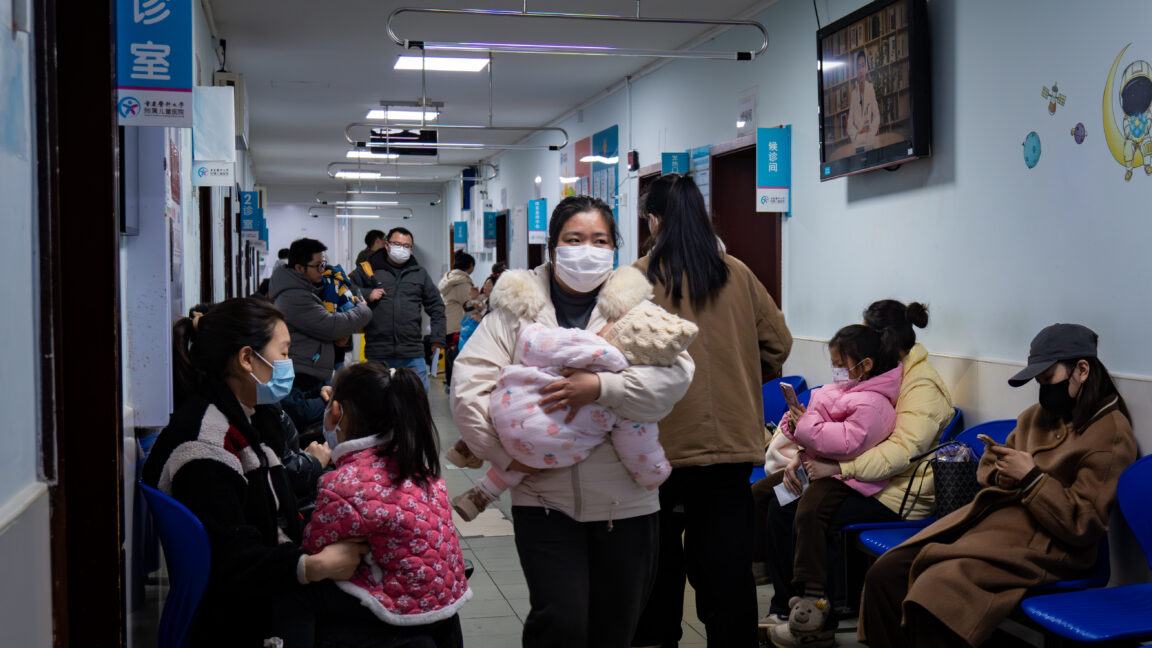
ARSTECHNICA.COM
China is having standard flu season despite widespread HMPV fears
That time of year China is having standard flu season despite widespread HMPV fears Data shows a completely normal respiratory illness season, WHO says. Beth Mole Jan 8, 2025 4:05 pm | 8 Children accompanied by their parents wait to receive treatment at a children's hospital amid a spike in respiratory illnesses on January 7, 2025 in Chongqing, China. Credit: Getty | Li Hongbo Children accompanied by their parents wait to receive treatment at a children's hospital amid a spike in respiratory illnesses on January 7, 2025 in Chongqing, China. Credit: Getty | Li Hongbo Story textSizeSmallStandardLargeWidth *StandardWideLinksStandardOrange* Subscribers only Learn moreThere's a good chance you've seen headlines about HMPV recently, with some touting "what you need to know" about the virus, aka human metapneumovirus. The answer is: not much.It's a common, usually mild respiratory virus that circulates every year, blending into the throng of other seasonal respiratory illnesses that are often indistinguishable from one another. (The pack includes influenza virus, respiratory syncytial virus (RSV), adenovirus, parainfluenza virus, common human coronaviruses, bocavirus, rhinovirus, enteroviruses, and Mycoplasma pneumoniae, among others.) HMPV is in the same family of viruses as RSV.As one viral disease epidemiologist at the US Centers for Disease Control summarized in 2016, it's usually "clinically indistinguishable" from other bog-standard respiratory illnesses, like seasonal flu, that cause cough, fever, and nasal congestion. For most, the infection is crummy but not worth a visit to a doctor. As such, testing for it is limited. But, like other common respiratory infections, it can be dangerous for children under age 5, older adults, and those with compromised immune systems. It was first identified in 2001, but it has likely been circulating since at least 1958.The situation in ChinaThe explosion of interest in HMPV comes after reports of a spike of HMPV infections in China, which allegedly led to hordes of masked patients filling hospitals. But none of that appears to be accurate. While HMPV infections have risen, the increase is not unusual for the respiratory illness season. Further, HMPV is not the leading cause of respiratory illnesses in China right now; the leading cause is seasonal flu. And the surge in seasonal flu is also within the usual levels seen at this time of year in China.Last week, the Chinese Center for Disease Control and Prevention released its sentinel respiratory illness surveillance data collected in the last week of December. It included the test results of respiratory samples taken from outpatients. Of those, 30 percent were positive for flu (the largest share), a jump of about 6 percent from the previous week (the largest jump). Only 6 percent were positive for HMPV, which was about the same detection rate as in the previous week (there was a 0.1 percent increase).Among hospitalized patients, flu accounted for nearly 18 percent of sampled respiratory cases (an increase of 5 percent from the previous week), while HMPV accounted for about 5 percent (an increase of 1 percent).Among outpatients, hospitalized patients, patients in southern provinces, and patients in northern provinces, influenza was the leading cause of respiratory illnesses across the board. HMPV ranked third in all categories except among outpatients in the northern provinces, where it ranked second. Across all age groups0-4, 5-14, 15-59, 60 and upinfluenza was the leading cause of respiratory illnesses.No cause for concernStill, amid drummed-up concerns, health organizations worldwide have felt compelled to address HMPV in China.In a statement released Tuesday, the World Health Organization summed up the situation:Chinas reported levels of acute respiratory infections, including hMPV, are within the expected range for the winter season with no unusual outbreak patterns reported. Chinese authorities confirmed that the health care system is not overwhelmed, hospital utilization is currently lower than this time last year, and there have been no emergency declarations or responses triggered.On Wednesday, health officials in Europe also released a statement about their lack of concern:Based on the current information, the European Centre for Disease Prevention and Control (ECDC) considers that the current epidemiological situation in China reflects a seasonal rise in respiratory infections caused by common respiratory pathogens and does not pose any specific concern for the EU/EEA.In the US, the CDC has provided media statements saying it is "monitoring reports" of HMPV and that they are "not currently a cause for concern in the US."In all, while respiratory illness season is nothing to sneeze at, HMPV fears have been overblown.Beth MoleSenior Health ReporterBeth MoleSenior Health Reporter Beth is Ars Technicas Senior Health Reporter. Beth has a Ph.D. in microbiology from the University of North Carolina at Chapel Hill and attended the Science Communication program at the University of California, Santa Cruz. She specializes in covering infectious diseases, public health, and microbes. 8 Comments
0 Commenti
0 condivisioni
147 Views


